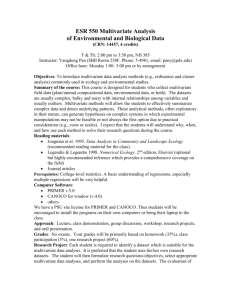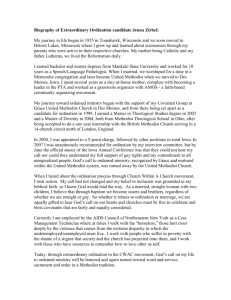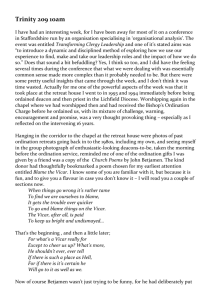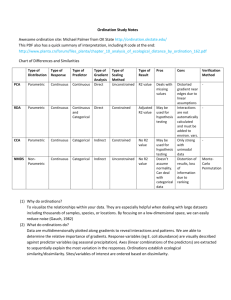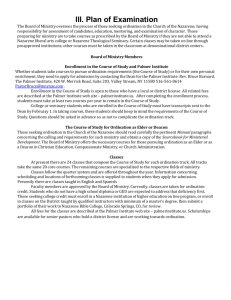Measuring Biological Diversity
advertisement
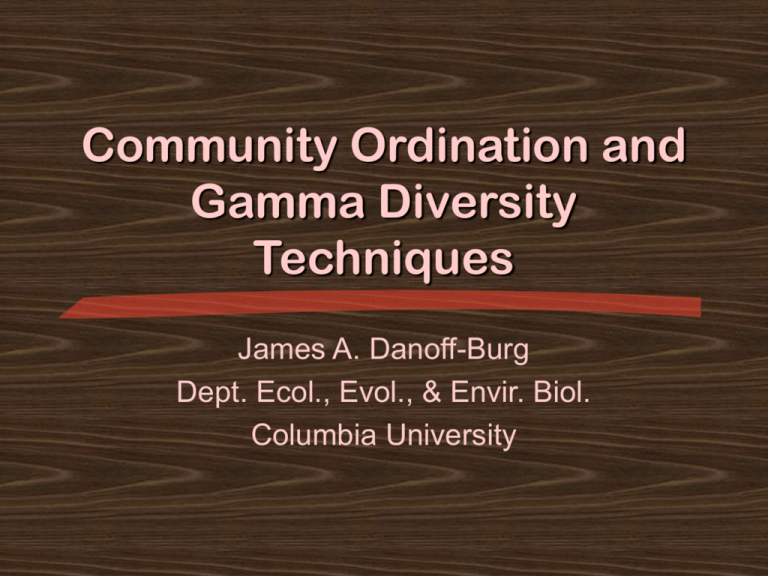
Community Ordination and Gamma Diversity Techniques James A. Danoff-Burg Dept. Ecol., Evol., & Envir. Biol. Columbia University Ordination vs. Cardinal Indices Cardinal Indices treat all species equally What we’ve been doing thus far Disproportionate influence was accorded to superabundant species • Purely as a consequence of the index calculation Ordinal Indices allows for extra weight to some species Incorporate other biological information Lecture 7 – Community Ordination & Gamma Diversity © 2003 Dr. James A. Danoff-Burg, jd363@columbia.edu Uses for Ordination Type of biological information to include Rare species Species of conservation importance Taxonomically diverse communites • Weight those with many unique lineages • Weight those with disparate lineages Keystone species Commercially valuable species Lecture 7 – Community Ordination & Gamma Diversity © 2003 Dr. James A. Danoff-Burg, jd363@columbia.edu Methods of Ordination Many methods of ordination All involve assigning a weight to a each species Abundance can also be involved in weighting system Weighting is done according to desires of researcher Rarity Conservation importance Taxonomic uniqueness Keystone species After weighting Can then do straight diversity analyses on these weighted values Lecture 7 – Community Ordination & Gamma Diversity © 2003 Dr. James A. Danoff-Burg, jd363@columbia.edu Weighting – an Example Taxonomically – two possible methods (Stiling 1996) l Sl/l % Branch Value w % Branching 1 6.25 4 3.5 10.7 1 6.25 4 3.5 10.7 2 12.5 3 4.67 14.3 4 25 2 7 21.4 8 50 1 14 42.9 16 100 14 32.7 100 Places great weight on taxonomically rare species Lecture 7 – Community Ordination & Gamma Diversity Information Index Places more equal weight on taxonomically rare species © 2003 Dr. James A. Danoff-Burg, jd363@columbia.edu Gamma Diversity Comparisons across ecosystems within a biome or larger region Usually want to determine the degree of similarity between disparate habitats Similarity determined by shared species Usually done using community ordination analyses Also interested in explaining why similarities exist Usually abiotic or landscape features Most work has been done on plants Lecture 7 – Community Ordination & Gamma Diversity © 2003 Dr. James A. Danoff-Burg, jd363@columbia.edu Data in Ordination Analyses When comparing sites, use similar data to what we’ve used thus far Richness Abundance Ordinal weights of each species Lecture 7 – Community Ordination & Gamma Diversity © 2003 Dr. James A. Danoff-Burg, jd363@columbia.edu Community Ordination Techniques Methods of analysis Cluster Analysis Indicator Species Analysis (ISA) Principal Components Analysis (PCA) • Sometimes called Principle Components Analysis Canonical Correspondence Analysis (CCA) Detrended (Canonical) Correspondence Analysis Lecture 7 – Community Ordination & Gamma Diversity © 2003 Dr. James A. Danoff-Burg, jd363@columbia.edu Cluster Analysis Stream similarity by invertebrates Used least impaired sites Stribling, et al. (1998) Natural species distributions, not human disturbance created clusters Site clusters were best explained by ecoregion Lecture 7 – Community Ordination & Gamma Diversity © 2003 Dr. James A. Danoff-Burg, jd363@columbia.edu Indicator Species Analysis Description a simple procedure for identifying those species that show strongly preferential distributions with respect to predefined groups Predefined Groups • might be those identified by cluster analysis • might be clustered in terms of environmental variables • might be treatment levels in an experimental design Result is that those species that best coincide with the predefined groups have highest values Resources on ISA http://www.env.duke.edu/landscape/classes/env358/mv_lab6.pdf http://wiseman.brandonu.ca/article2.htm Lecture 7 – Community Ordination & Gamma Diversity © 2003 Dr. James A. Danoff-Burg, jd363@columbia.edu Principal Components Analysis PCA Takes a set of variables and defines new variables that are linear combinations of the initial variables Extracts most variance from data • Plots sample points in an n-dimensional cloud • Longest axis of the cloud is the primary axis Need to plot the data points to determine meaning of axes • Not always clear • Can be many explanatory factors Correlating multiple dependent variables with each other Mostly exploratory Lecture 7 – Community Ordination & Gamma Diversity © 2003 Dr. James A. Danoff-Burg, jd363@columbia.edu PCA Example PCA of human disturbance measures using diatoms Many different types of human disturbance within each watershed Bryce et al. (1999) Summarize the risk of human disturbance in a watershed Created a disturbance index PCA Different combinations of variables were tested the set that best approximated the subjective disturbance index PCA axis1 correlated with chloride, total N, riparian condition measures, road density, % urban, forest, agriculture, and mine cover Lecture 7 – Community Ordination & Gamma Diversity © 2003 Dr. James A. Danoff-Burg, jd363@columbia.edu Canonical Correspondence Analysis Method Takes 2 sets of variables • Multiple dependent variables • Multiple independent variables Creates new variables for each set such that the correlation of the new variables is maximized You give the model 2 sets of variables and the model returns pairs of new variables • made from linear combinations of the original variables • Each new variable includes those that are the most highly correlated Lecture 7 – Community Ordination & Gamma Diversity © 2003 Dr. James A. Danoff-Burg, jd363@columbia.edu CCA Example Hill, et al. (in review) Exploratory evaluation of the relationship between measures of human disturbance and candidate diatom metrics Determined canonical axes for both sets of variables (DV & IV) First canonical axis • derived from human disturbance measures • test for differences in genus- and species-level identification of diatoms Diatom species that tolerate nutrient enrichment (Eutraphentic taxa) increased significantly with human disturbance – but number of genera did not. Lecture 7 – Community Ordination & Gamma Diversity © 2003 Dr. James A. Danoff-Burg, jd363@columbia.edu Detrended Canonical Correspondence Analysis Floral analysis along the Hood River in Canada Sites found on uplifted marine sediments (below 150 m) separate out as floristically distinct from sites found above the uplifted sediments. All sites share a large percentage of species (30%) Separation along the first axis is related to gradients in soil pH and a complex gradient in elevation. Separation along the second DCA axis is unexplained Hood (1995) Lecture 7 – Community Ordination & Gamma Diversity © 2003 Dr. James A. Danoff-Burg, jd363@columbia.edu
